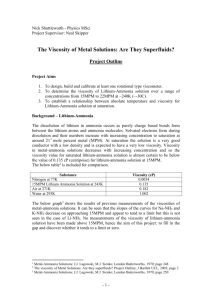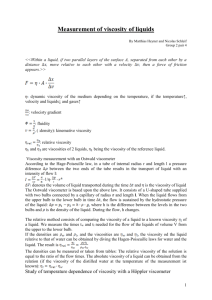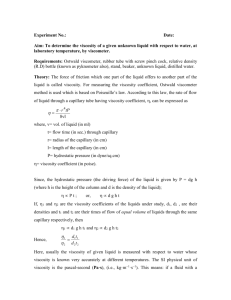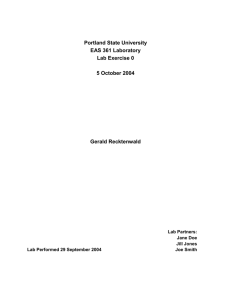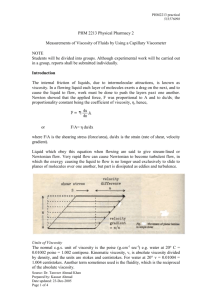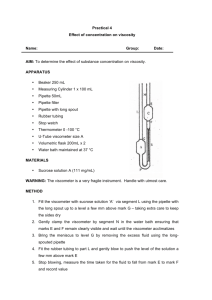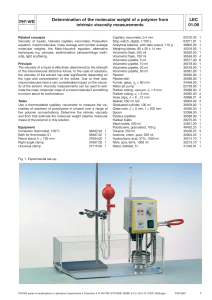LAB322#44
advertisement
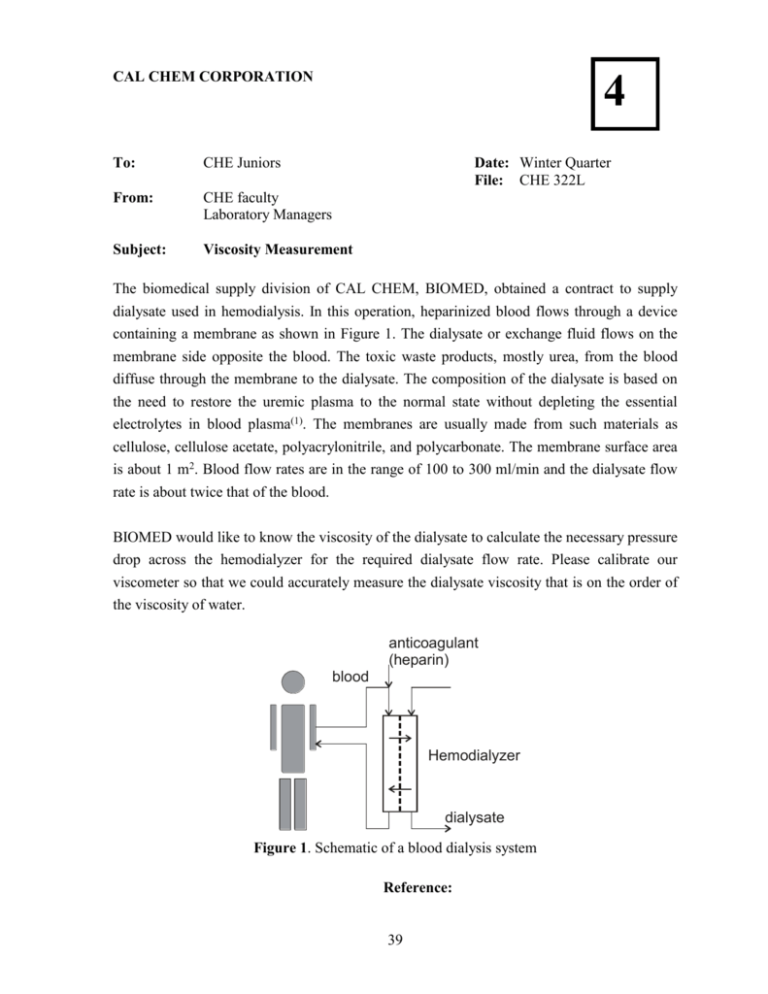
4 CAL CHEM CORPORATION To: CHE Juniors Date: Winter Quarter File: CHE 322L From: CHE faculty Laboratory Managers Subject: Viscosity Measurement The biomedical supply division of CAL CHEM, BIOMED, obtained a contract to supply dialysate used in hemodialysis. In this operation, heparinized blood flows through a device containing a membrane as shown in Figure 1. The dialysate or exchange fluid flows on the membrane side opposite the blood. The toxic waste products, mostly urea, from the blood diffuse through the membrane to the dialysate. The composition of the dialysate is based on the need to restore the uremic plasma to the normal state without depleting the essential electrolytes in blood plasma(1). The membranes are usually made from such materials as cellulose, cellulose acetate, polyacrylonitrile, and polycarbonate. The membrane surface area is about 1 m2. Blood flow rates are in the range of 100 to 300 ml/min and the dialysate flow rate is about twice that of the blood. BIOMED would like to know the viscosity of the dialysate to calculate the necessary pressure drop across the hemodialyzer for the required dialysate flow rate. Please calibrate our viscometer so that we could accurately measure the dialysate viscosity that is on the order of the viscosity of water. anticoagulant (heparin) blood Hemodialyzer dialysate Figure 1. Schematic of a blood dialysis system Reference: 39 1. Fournier, R. L., Basic Transport Phenomena in Biomedical Engineering, p. 154, Taylor Francis, 1998 40 CHE 322 TRANSPORT LABORATORY Experiment No. 4 VISCOSITY MEASUREMENT Introduction A number of devices are available to measure the viscosity of a Newtonian fluid. However, an accurate determination of viscosity requires a careful analysis of the experimental technique that is used. To study some of the problems involved in viscosity measurement, a Cannon-Fenske and a Stormer viscometer will be considered. The Cannon-Fenske viscometer is a capillary type viscometer with its main component shown in Figure 1. To make a measurement, suck the liquid past the upper etched line and then release it. The efflux time tefflux required for the liquid level to pass from the upper to the lower etched line is measured. Since the efflux volume Vefflux between the etched lines is calibrated, the average volume flow rate Q through the capillary is given by Q = Vefflux /tefflux (1) Etche d l i ne s Cap i ll a ry Fig. 1 Capillary viscometer. 41 The volumetric flow rate through the uniform capillary described above can also be obtained from application of the steady momentum balance to the laminar flow of fluids. The resulting equation is the Hagen-Poiseuille relationship (Ref. 1). Q = R4P/(8L) (2) where P R L = total up-stream pressure minus total downstream pressure = capillary radius = capillary length = absolute viscosity If the total pressure change is due to hydrostatic head alone, Eq. (2) can be written as = g(h)R4/(8QL) g h = acceleration of gravity = upstream hydrostatic head minus downstream hydrostatic head = kinematic viscosity (3) where Using Q from Eq. (1), the kinematic viscosity can be obtained = [g(h)R4/(8LVefflux)] tefflux = C tefflux (4) where the quantity in square bracket is a known constant C for a given viscometer. Experimental Work There is a black, loose-leaf binder containing background information on viscometers and two ASTM (American Society for Testing Materials) procedures for viscometers. D-445 is more general. D-446 is more specific. There is viscosity data for castor oil vs. temperature and for aqueous glycerol vs. concentration. Please look at all articles. Use of Cannon-Fenske (C-F) viscometer tubes We have a number of Cannon-Fenske viscometer tubes. You must determine the correct size of the C-F tube for each fluid using Table 1. If the recommended size is not used for the viscosity range you should discuss the consequences in the report. The instructions for the Cannon-Fenske viscometer are (from the manual): 1. The viscometer should be cleaned with a suitable solvent and dry, clean, filtered air should be blown through the viscometer to remove any remaining traces of solvent. 2. The instrument should be periodically cleaned with chromic acid to remove any possible traces of organic deposits. 3. If a possibility of lint, dust, or other solid material is present in liquid sample, this may be removed by filtering through a sintered glass filter or fine mesh screen. 4. To introduce sample into the viscometer, invert viscometer and immerse tube “A” into liquid. Apply suction to “J” which causes the sample to rise to etched line “E”. Turn the viscometer to normal position and wipe tube “A” clean. - An alternative step is to use a pipette and pour liquid into leg “J”. 5. Insert the viscometer into a holder and place in Constant-Temperature Bath. Allow 10 minutes for viscometer to reach equilibrium at 100oF and 15 minutes at 210oF. 42 A B C D J E F H G Fig. 2 Cannon-Fenske Routine Viscometer 6. Vertical alignment may be accompanied in bath by suspending a plumb bob in tube “J”. 7. Apply suction to tube “A” and bring sample into bulb “D”, a short distance above mark “C”. 8. The efflux time is measured by allowing the sample to flow freely through mark “C”, measuring the time for the meniscus to pass from “C” to “E”. 9. To repeat efflux time, repeat steps 7 and 8. You must determine the viscometer (calibration) constant for every C-F tube. The viscometer constant is determined by using the same procedure for a liquid of known viscosity (at the measured temperature). The following table provides the recommended viscosity ranges and the approximate constant for each size C-F tube. Table 1 Recommended Viscosity Ranges for The C-F Viscometers Size 20 50 75 100 150 200 300 350 400 450 Centistoke/Second Approximate Constant 0.002 0.004 0.008 0.015 0.035 0.1 0.25 0.5 1.2 2.5 43 Centistokes Range 0.5 to 2 0.8 to 4 1.6 to 8 3 to 15 7 to 35 20 to 100 50 to 250 100 to 500 240 to 1200 500 to 2500 500 8 1600 to 8000 First you must determine the sample size for the C-F tubes. Also determine the viscometer constant, using distilled water, for three tubes of the same size. Make up a solution of 10.0 w% of aqueous glycerol and determine its viscosity at five different temperatures from about 70. to 150.oF. Use distilled water to calibrate the tube used. Make up a solution of 40.% aqueous glycerol and determine its viscosity at five different temperatures from about 70. to 150.oF. Use the 70.oF, or room temperature viscosity, of the 10.% glycerol for calibrating. We will be using the oil filled, temperature controlled bath in the transport laboratory. You might need a light to illuminate the bath for ease in making readings. The bath heats quickly but cools slowly ... so plan accordingly. The heating element control has H, M, ML and L(ow) settings. The control has a magnetic drive unit so it is necessary to turn the control knob slowly. You can heat quickly by starting on H(igh), but then you must change to a lower setting so that you don’t overshoot the temperature. Note that there are cooling coils which can be used to cool the bath (if you connect them to the cooling water supply), but you will not be able to cool the bath quickly. Record the efflux time from three to six times for each viscosity measured. If there is a noticeable difference between the times thus measured, the viscometer may be dirty, the stopwatch may be inaccurate or there may be some other problem. In any case take corrective action. When finished, thoroughly clean the viscometers and turn off the thermostat. Calculate all viscosities, both kinematic and absolute. Calculate the best average viscosity for each solution and each temperature. You should fit the data obtained for the two solutions to the following equations: viscosity = Aexp(-BT) viscosity = Aexp(-B/T) where A and B are constants and T is the absolute temperature in oR. Also compare the measured viscosity of the 10.% glycerol with the literature value. The Stormer Viscometer (Viscosimeter) The Stormer viscometer consists of two concentric cylinders, one of which is rotated while the other is held stationary. The fluid viscosity can be determined from the rotational speed and the torque T on the cylinder (Ref. 1, pg. 146-149). T = C where is the angular speed. The constant C can be calibrated by a liquid with known viscosity. Try to take as much data as possible since you might not have enough time to perform all the experiments recommended in this section. 44 This version of the Stormer viscometer is easy to operate, produces results quickly and is adaptable to a variety of materials, in contrast to the Cannon-Fenske tube. However it is not as accurate as C-F. See the information folder in the laboratory for the Stormer instructions. What size sample is required? Set up the viscometer according to the instructions. Calibrate it with distilled water and 40.0% glycerol solution. Measure the viscosity of the 20.0% glycerol solution at room temperature. Bring a sample, of a viscous hydrophilic material, from home for testing. Some examples are catsup, chili sauce, condensed milk, honey, mustard, pancake syrup or a cornstarch solution. Test this sample at room temperature using appropriate loads. Plot revolutions per second versus load. How would you describe the flow properties of your sample? Look up the viscosities of 40.w% sucrose solutions in a table in one of the references. Prepare a viscosity-temperature plot, over the range from 0 - 100oC, using the Arrhenius type relationship. Determine the two constants for the least squares line. Report The Cannon Fenske results are the viscosity versus temperature graphs for the two equations. Which relationship gives the better correlation? Also list the viscometer constants for the three tubes of the same size. How much do they vary? Why do they vary? Use a table to express the Stormer viscosity results. Calculate the viscosity of the 20.% glycerol sample using the viscometer constant from both the distilled water and 40.% glycerol. How do these viscosities compare with each other and with the literature value? The results of the viscosity measurements of the viscous, hydrophilic sample at different loads should be presented using a graph. The following questions should be answered: 1. Could you calculate the viscometer constant for a C-F tube, using an equation (not using the draining time)? 2. What would you have to do to calculate the viscometer constant for the Stormer viscometer? 3. For the capillary-type viscometers it has been found that, under certain conditions of fluid properties and/or for different viscometer tube, the kinematic viscosity is best related to the efflux time by the following equation: = C tefflux - B/tefflux (5) where C and B are constants. a. Explain the theoretical significance of this equation. b. Under what experimental conditions will Eq. (5) reduce to Eq. (4). c. How would one evaluate the constants, B and C, experimentally? 45 4. In the development of Eq. (4) it was assumed that a fully developed velocity-profile exists in the capillary tube at all times and is directly related to the instantaneous hydrostatic-head across the capillary. Discuss the validity of this assumption. Is this a quasi steady-state assumption? References 1. Middleman, Stanley, An Introduction to Fluid Dynamics, Wiley, (1998), pg. 68-74 2. Crosby, E. J., Experiments in Transport Phenomena, Wiley, (1961), pg. 1-14. 3. Aronson M. H. and Nelson R. C., Viscosity Measurement and Control, Instruments Publishing, (1964). 46

